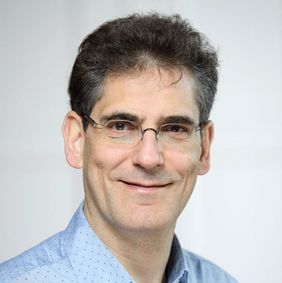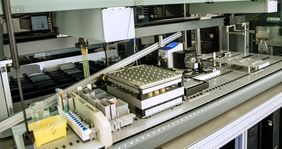Agilent Technologies Inc., a leading scientific instruments and technologies company, has selected Prof. Dr. Peter Neubauer for its Thought Leader Award, recognizing his exceptional contributions of analytics in the area of bioprocess engineering. Prof. Neubauer is a UniSysCat group leader, heads the Chair of Bioprocess Engineering at Technische Universität Berlin, and is the co-founder and head of the Kiwi-biolab and of the Bio-PAT e.V. His team of researchers, students, and technical staff have been a driving force in developing innovative methods for efficient bioprocess development, with an emphasis on automation and industrial-scale applications. We asked Prof. Neubauer a few questions about his work and his achievements:
Could you briefly describe your main research topics and what role UniSysCat plays in your work?
At the chair of bioprocess engineering, we are methodically concerned with how bioprocesses can be developed more quickly and thus more cheaply. As a trained microbiologist, I have always been interested in better understanding the physiology of microorganisms in industrial processes.
The production of specific target proteins in genetically engineered cells is a standard method in industrial biotechnology and biopharmaceutical technology, used to produce many protein drugs such as, e.g., insulin, antibodies and blood factors. We are particularly interested in so-called difficult to express proteins. These include larger proteins consisting of several subunits, for example, in which the formation of the three-dimensional structure is slow and which are often modified post-translationally after their production. A pertinent exemplar of such complexity are hydrogenases, addressed in the UniSysCat Cluster of Excellence. Recombinantly produced hydrogenases hold the potential as interesting catalysts for hydrogen formation, to be used in biofuel cells, or even deployed as continuous regeneration systems for diverse biocatalytic syntheses. Characterized by their intricate architecture, these hydrogenases consist of multiple subunits and incorporate reactive nickel-iron clusters at their catalytic core, necessitating the involvement of specific auxiliary proteins for the integration of these clusters. In order to yield the desired active target molecule in substantial quantities while minimizing inactive byproducts, it becomes imperative to intricately calibrate the cellular synthesis processes. This requires careful orchestration of sequential synthesis events and minimal interference with the cellular factory itself.
An illustrative example is our efforts to express the soluble regulatory hydrogenase in the bacterium Escherichia coli. This attempt entailed the expression of not only the two structural genes of the enzyme, but also an additional five genes responsible for maturation and assembly of the nickel-iron cluster. Beyond gene expression, careful optimization of environmental conditions and feeding strategies, as well as fine-tuning of the feeding of the critical nickel and iron ions for the metal centers, emerged as critical factors. These multi-faceted optimizations inherently involve a complicated interplay of numerous factors that typically rely on lengthy trial-and-error approaches.
Ultimately, by combining our interdisciplinary expertise in cell physiology, genetic engineering, and process engineering, we finally succeeded in generating over 100 mg of functional hydrogenase per liter of culture volume. This achievement is currently the highest yield reported in the literature.
What impact will this award have on your research, specifically the research connected to UniSysCat?
We are currently trying to transfer the lessons we have learned from the regulatory hydrogenase to more complicated hydrogenases with a higher practical relevance. In our KIWI-biolab, we are now trying to make these processes much more efficient by combining efficient experimental design strategies and laboratory automation with AI and machine learning methods, whose use in bioprocesses is still in its infancy.
Addressing the numerous questions that arise and ultimately overcoming the challenges necessitates comprehensive analytical tools. Integrating well-established analytical approaches such as liquid chromatography and mass spectrometry into our automated laboratory workflow presents a distinct challenge. This challenge is the focus of the exciting cooperation with Agilent, made possible by the “Thought Leader Award”. We anticipate that this collaboration will particularly enrich the hydrogenase project, and that it will enable us to provide good amounts of different catalytically active hydrogenases to our cooperation partners within the UniSysCat cluster more quickly.
How did you find your research field and what is your scientific approach?
I have always been interested in basic research issues and wanted to understand natural phenomena from the ground up. But I also was specifically interested in their potential application. In this regard, I was fascinated by the different approaches of engineers to natural scientists during my postdoc at a Department of Bioprocess Engineering at the Royal Institute of Technology (KTH) in Stockholm, Sweden. Since then, I have always attached great importance to this and have enjoyed working in interdisciplinary teams. Critical for success is that all partners are open to delve as deeply as possible into the other domains and then contribute their specific competences to solve the respective scientific question. Only in this way we can really benefit from mathematical models, modern process control and AI in a meaningful and convincing way. In the UniSysCat Cluster of Excellence, this inter- or better transdisciplinarity is practiced to the full extent in order to scientifically address exciting questions that need to be solved from a specific direction. I am grateful to be part of this large network of excellent research and hope that we can make significant contributions.
For more information, check out the press release from cooperation partner Bio-Pat here and the TU interview here.




